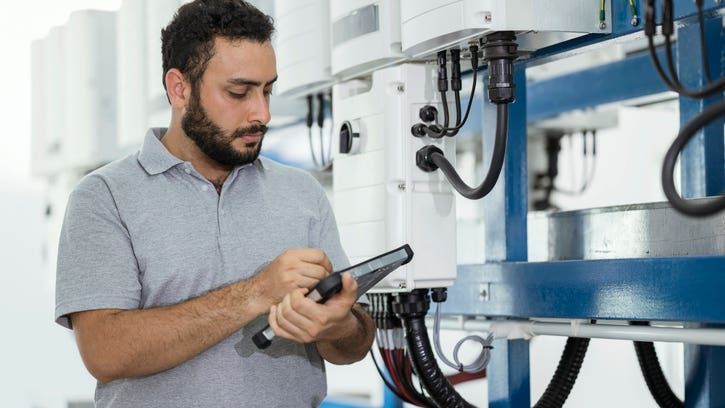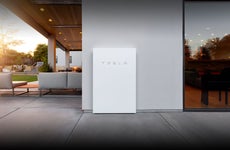Cost Of Solar Batteries in 2024

The Bankrate promise
At Bankrate we strive to help you make smarter financial decisions. While we adhere to strict , this post may contain references to products from our partners. Here's an explanation for .
Key takeaways
- The cost of popular solar batteries ranges from $6,000–$23,000.
- Solar batteries store excess generated energy for later use during a power outage, at night and on cloudy days.
- The total cost varies based on the manufacturer, battery type, power capacity, installation fees and other factors.
- Financial incentives are available to reduce the total price.
Battery storage systems are one of the latest technologies revolutionizing the clean energy transition. Solar batteries can reduce your reliance on the electricity grid by storing surplus energy generated from solar panels to use when the sun is less available. If you have considered solar or own a home with solar panels, you likely have also considered installing a solar battery. The cost can total about half the price of the average solar system, depending on several factors, such as the number of solar batteries your home needs. Read on to learn if solar batteries are worth it to you, what makes up the cost, benefits and more.
Can solar panels and batteries save you money?
What is the cost of solar batteries?
Solar batteries are expensive and are not a one-size-fits-all product. The battery size you need for your home is determined by your energy usage. If you use more energy, you may need two solar batteries to power your home, which increases the cost. Data from the National Renewable Energy Laboratory (NREL) estimates the total cost of a solar battery, including installation, is $18,791. Installation and permitting fees vary by location and installer, but the NREL cost estimate for the standalone battery is $16,007.
Solar incentives and rebates are available to reduce the cost of a solar system, including solar storage. For example, the federal tax credit, known as the Residential Clean Energy Credit, offers a 30 percent credit on the total cost of solar, including batteries. Before incorporating additional fees, the federal tax credit can save you nearly $5,000 on the NREL estimated solar panel battery price. Some battery manufacturers also provide financial incentives.
Battery type also influences the cost. Lithium-ion batteries are the most common type paired with a residential solar system. They are usually more expensive than lead-acid batteries, but lithium-ion batteries are larger in size and store more energy to power your home.
How much does a solar battery cost in 2024?
It depends. As we’ve covered, the total cost varies based on storage size, market value, installation fees and other factors. If you install a solar battery at the same time as panels, your total installation cost will be less than if you install it separately.
Compare the pre-incentive cost of popular solar batteries in the following table. The prices included are for one battery, though you may need to install more depending on your energy usage and storage goals. Getting quotes from solar companies provides the most accurate solar battery prices because it includes additional fees specific to your location, such as taxes and installation labor.
| Battery | Starting Cost | Power Capacity (kilowatt-hour) |
| Tesla Powerwall 2 | $8,400 | 13.5 kWh |
| LG 10H Prime | $6,000 | 9.6 kWh |
| Generac PWRcell | $10,000 | 3 kWh |
| sonnenCore+ | $10,300 | 10 kWh |
| SunPower SunVault | $16,000 | 13 kWh |
Are solar batteries worth the price and do you need one?
You can benefit from battery storage, regardless if you have rooftop solar. Solar batteries store excess energy for later use when the sun is less available, such as at night, on cloudy days and in winter. Depending on the time of year, solar panels can generate more energy than your home needs. Batteries can reduce your reliance on the electricity grid and potentially help lower your utility bill by using stored energy when time-of-use (TOU) rates are more expensive. Solar batteries are especially worth the investment if:
- You frequently experience power outages.
- You want to go completely off the grid with solar.
- You’re on a time-of-use energy plan.
Solar owners without solar storage may use their state’s net metering benefits in place of a battery. Solar batteries are especially beneficial in states like California, where the most recent net metering policy reduces the value of energy credits. Net metering is an agreement between solar owners and the utility company where excess energy generated from your system is sent to the utility company in exchange for energy bill credits. If the credit is low, having a battery storage system will maximize your solar panel system investment and save more money in the long run.
Solar batteries are not a required part of a solar system but can be worth it during power outages and for those with TOU energy plans. You can save money by using stored energy during peak hours when electricity rates are the most expensive.
If you’re not home for most of the day, you likely will not use all the solar energy your system produces. The excess generation will be sent to the grid or you can save it in a solar battery for use when you are home. This is helpful for combatting peak energy demand and high electricity rates. Alternatively, if you do not have rooftop solar but are on a TOU plan, you can store electricity from the grid during off-peak hours for use when rates are higher. Strategic energy consumption is key to lower energy bills for TOU plans.
Factors that impact solar battery price
- Number of batteries installed: The more battery units you install, the higher the total price. The number of batteries depends on the storage capacity and the amount of stored energy needed for your home. If you start with one, you can easily add another at a different time, but the total cost may be higher due to installation fees.
- Battery chemistry: Most solar batteries use lithium-ion for solar energy storage. Lead-acid batteries are available and are typically cheaper, but they store less energy and do not last as long as lithium-ion.
- Manufacturer: The brand’s services and manufacturing process impact the price. If the brand’s costs for manufacturing are higher, the price of the battery will likely be higher. Some installers offer a discount on the solar battery if you add it to a new solar system at the time of initial purchase.
- Power capacity: The amount of usable energy a battery can store. Typically, the higher the power capacity, the higher the price. The Generac PWRcell is an exception, costing $10,000 with only a 3 kWh capacity. If you want to power more essential appliances during an outage, you will want a battery with higher capacity.
- Critical load panels: If your home doesn’t already have a critical load panel, the electrical work to install one will increase the total cost. Critical load panels are a secondary circuit board to power essentials during an outage. You can configure your battery and critical load panel to support necessary appliances during outages.
- Inverters: Solar batteries, like the Tesla Powerwall, are equipped with an inverter, while others, like the LG Chem Resu, are not. Adding standalone inverters to your system increases the total price
- Incentives and rebates: Solar batteries are eligible for the 30 percent federal solar tax credit. You can apply through the IRS to receive a credit on your next federal income taxes. This credit can be applied to batteries purchased from 2022 through 2032. Check with your local utility for additional incentives.
Powering your home with green energy doesn’t have to be a financial burden. Solar financing options allow you to increase your energy independence on any budget. There are many ways to pay for eco-friendly home upgrades, including personal loans and HELOCs.
Frequently asked questions
-
At least 10 years based on the industry standard warranty. The lifespan of your solar battery will depend on the battery type and how much you use it. A solar battery’s lifespan is based on cycles of charging and discharging before the capacity degrades. Just like a cell phone battery, a solar battery loses its ability to hold a charge over time. For those seeking peace of mind and flexibility, choosing a battery with an unlimited cycle clause in its warranty offers the freedom to utilize the battery as much as you want without concerns about its lifespan.
-
The benefits of solar batteries include the ability to store excess energy from the grid or your solar system to use during a power outage or times when electricity is most expensive. Installing a solar battery increases your self-consumption to reduce your reliance on the grid and contributes to a more sustainable energy future. The main drawback is the initial cost of solar batteries. Fortunately, the 30% Residential Clean Energy Credit applies to batteries, so you can pay less.
-
Yes. You can charge your solar battery by pulling energy from the electrical grid, if permitted by your local utility policy. TOU energy plan consumers can potentially save money if you charge and store energy during off-peak hours and then discharge when rates are more expensive.
-
Capacity, efficiency and cycle life are among the most important factors to assess. Capacity determines how much energy a battery can store, efficiency impacts its ability to effectively store and release energy and cycle life indicates how long the battery can last. Factor in the warranty, safety features and compatibility with existing systems to make an informed decision about the right solar battery for your home.
Related Articles

Home generators: How much do they cost and should you have one?


